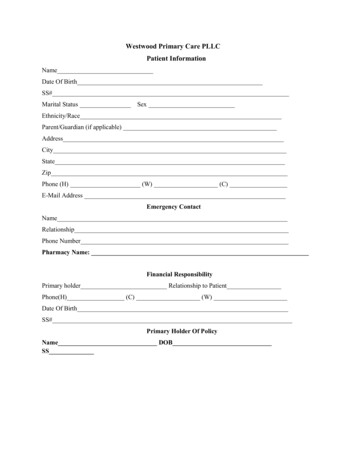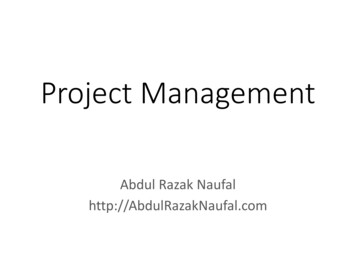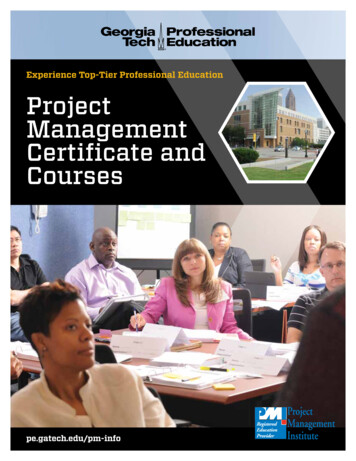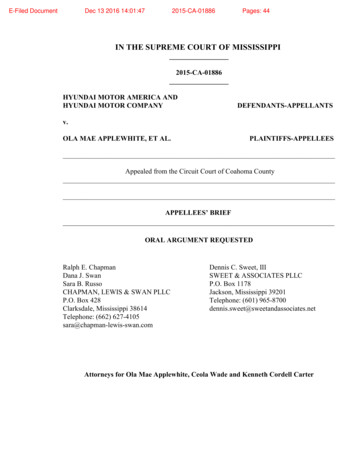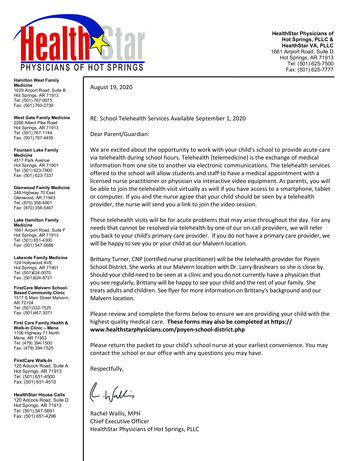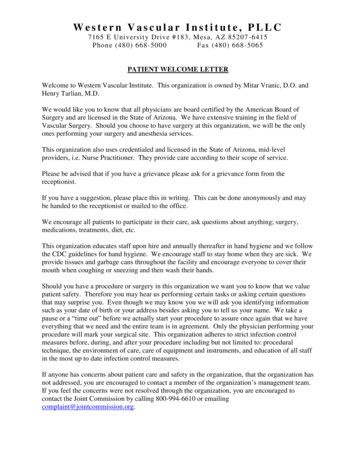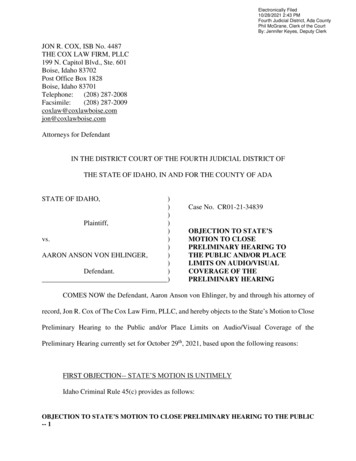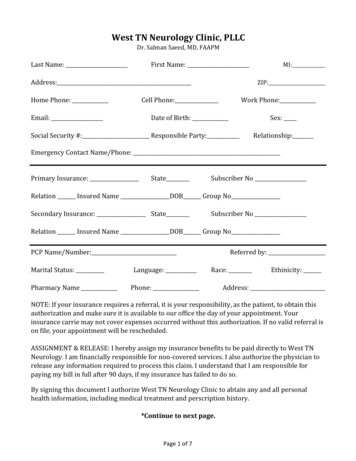
Transcription
LEGAL PROJECTMANAGEMENTA better way for lawyers to workwith landlord and tenant clients.January 2018Itkowitz PLLCitkowitz.com
Legal Project Management; Copyright 2018 by Michelle Maratto Itkowitz; www.itkowitz.comLEGAL PROJECT MANAGEMENTA better way for lawyers and clients to work together.By Michelle Maratto ItkowitzITKOWITZ PLLC305 BroadwayNew York, New York 10007(212) ight 2018 by Michelle Maratto ItkowitzNo part of this publication may be reproduced, stored in or introduced into a retrieval system, ortransmitted in any form or by any means – electronic, mechanical, photocopying, recording, or otherwise– without the prior permission of the author and publisher. Requests for permission or inquiries about theauthor should be directed to mmaratto@itkowitz.com.While every precaution has been taken in the preparation of this book, the author and publisher assumeno responsibility for damages resulting from the use of the information herein. Receipt of this book by anyperson or entity does not create an attorney and client relationship between the recipient and the authoror her firm.Page 1 of 31
Legal Project Management; Copyright 2018 by Michelle Maratto Itkowitz; www.itkowitz.comTABLE OF CONTENTSCHAPTER 1: LEGAL PROJECT MANAGEMENT. 3A.Legal Project Management -- Introduction and Definition . 3B.Why LPM is a Better Way for Lawyers and Clients to Work Together . 4C.Principals of Legal Project Management. 6CHAPTER 2: INFORMATION GATHERING . 7A.Backstory . 7B.Questions to Ask a Client. 8C.Deeper Questions . 11D.Who are the Players? . 12CHAPTER 3: UNDERSTANDING AND DEFINING THE CLIENT’S GOALS . 15CHAPTER 4: PROJECT CHARTERS – LEGAL PROJECT MANAGEMENTLETTERS . 17CHAPTER 5: COMMUNICATION WITH THE CLIENT . 20A.Sharing Information with the Client . 20B.“A Fighting Chance” – Speaking in Terms of Numerical Percentages asopposed to Catch Phrases . 20CHAPTER 6: MANAGING LEGAL FEES . 21A.Estimates and Alternative Fees . 21B.Law is an Apprentice Profession -- Younger Lawyers and Their Role in theDelivery of Legal Services in a Value Driven Model . 22CHAPTER 7: LAWYERS AS RISK MANAGERS . 23A.Chess – Really? . 23B.Risk . 25CHAPTER 8: CRITICAL THOUGHT - "I hired you because you were the onlylawyer who did NOT tell me that you could win my case.". 26CHAPTER 9: WHEN THE BEST ENGAGEMENT IS NO ENGAGEMENT. 28CHAPTER 10: THE CASE FOR (AND AGAINST) LEGAL PROJECTMANAGEMENT . 29A.Why wouldn’t everyone practice this way? . 29B.Reason LPM Carries the Day . 29Page 2 of 31
Legal Project Management; Copyright 2018 by Michelle Maratto Itkowitz; www.itkowitz.comCHAPTER 1: LEGAL PROJECT MANAGEMENTA. Legal Project Management -- Introduction and DefinitionI wrote this book to teach Legal Project Management to three groups of people:(1) My clients, and potential clients;(2) The lawyers who work with me; and(3) The legal profession in general.In some chapters, I am obviously speaking to the client. In other chapters, I amobviously speaking to the lawyers. It doesn’t really matter which way I am directing myinstructions and arguments, all chapters are relevant for both clients and lawyers. LegalProject Management is an inherently collaborative way of working and its successdepends upon the buy-in of both lawyer and client.Project management is classically the stuff of manufacturing, construction,technology development, and other fields. When project management principles areimposed upon the practice of law, you get Legal Project Management.The definition that we have developed at Itkowitz PLLC for Legal ProjectManagement is:Legal Project Management is the discipline of managingresources (people and technology) to bring about thesuccessful completion of the specific goals of a legalcase (the client’s goals), while honoring the constraintsof the matter (time, money, relevant law).Page 3 of 31
Legal Project Management; Copyright 2018 by Michelle Maratto Itkowitz; www.itkowitz.comWhy don't more lawyers utilize Legal Project Management? Your guess is asgood as mine, at this point. The below graphic takes a stab at the answer.B. Why LPM is a Better Way for Lawyers and Clients to Work TogetherLegal Project Management (“LPM”) is a better way for lawyers and clients towork together, as compared with the vast dynamic that exists between attorneys andtheir clients today.In what I call “the old school model of delivery of legal services” (see belowgraphic), because initial assessment is expensive, lawyers tend to do less of it. Less indepth initial assessment necessarily leads to a lawyer and a client with a lesserunderstanding of the issues in the case, and a lesser understanding of the meaningfulchoices that exist. Less in-depth initial assessment also means that more of theassessment is done simultaneously with the execution, and, thus: things take longer;there are more surprises;it is harder to meet deadlines; andit is harder to stay within a budget.Page 4 of 31
Legal Project Management; Copyright 2018 by Michelle Maratto Itkowitz; www.itkowitz.comFurther, because the client was offered less choice, he has a smaller role indeciding on a course of action. Therefore, the client accepts less responsibility for theultimate outcome of such action. If the outcome is not one expected by and/orwelcomed by the client, then tension develops between lawyer and client. Under theold-school approach, the client becomes a necessary evil, gets updates grudgingly, andis not viewed as a partner in the legal project.In Itkowitz PLLC’s Legal Project Management system, the case is comprehendedas a series of manageable stages (or “Scopes of Work”). For each Scope of Workthere is a cycle of: AssessmentClient ChoiceExecution, andOutcome.After an Outcome is reached, the information gathered during the Scope ofWork feeds right back into the next stage of the case, and Assessment begins allover again for the next Scope of Work.With Legal Project Management (see below graphic), the Assessment phase isin-depth. By focusing the client and the firm on information gathering, risk assessment,and critical thinking from the inception of each stage, the client is better able to makechoices. Thereafter, in the Execution phase there is more room for allocating resources,budgeting, cost control, and deadline management. The client is, thereafter, notsurprised by the Outcome of the Scope of Work and owns the results, because thePage 5 of 31
Legal Project Management; Copyright 2018 by Michelle Maratto Itkowitz; www.itkowitz.comclient is making educated, informed choices. Again, after an Outcome is reached, theinformation gathered during the Scope of Work feeds right back into the next stage ofthe case, and Assessment begins all over again for the next Scope of Work. With theLegal Project Management approach, there is communication at every phase, and lotsof client involvement.C. Principals of Legal Project ManagementHow does LPM work specifically? For Itkowitz PLLC, Legal Project Managementis a unique, systematic, and stimulating approach to practicing law that stressesheightened attention to the following:1.Information GatheringWe seek to attain a deep understanding of your business model and yourlegal matter.2.Understanding and Defining the Client's GoalsWe constantly seek to clarify your goals for the engagement, even as theyevolve. We document and circulate those goals in a project charter.3.The Utilization of an Evolving Project Charter to Guide the CaseEvery significant project needs a Project Charter. And your litigation is asignificant project. Your case is of vital importance to you, you arespending a lot of money on it, it is complex, and there are many peoplePage 6 of 31
Legal Project Management; Copyright 2018 by Michelle Maratto Itkowitz; www.itkowitz.cominvolved both on the client side and on the firm side. Therefore, your casedeserves a Project Charter to keep the lawyer-client project team focusedon success. At Itkowitz PLLC the Project Charter is expressed through aseries of “Legal Project Management Letters”.4.Communication with the ClientWe communicate with you frequently and preemptively, in a variety ofways, and with absolute clarity.5.Allocating Resources, Budgeting, and Cost ControlWe provide you with realistic cost estimates and discounted and cappedfees, if appropriate.6.Risk ManagementWe help you to identify, assess, and prioritize risks in your case, and thencoordinate resources to minimize and monitor the probability and/orimpact of bad events.7.Critical ThinkingThis systematic approach forces one to consider the case methodicallyand think about it critically.CHAPTER 2: INFORMATION GATHERINGA. BackstoryAt Itkowitz PLLC we spend a great deal of time at the outset of a matter, typicallyat little or no charge to the client, gathering all types of information and trying tounderstand what is really going on. It is not always so obvious, even when dealing witha very professional and focused client.Here is a roofer analogy. If a building owner hired a roofer, certainly one wouldacknowledge that the roofer needs information before starting to install a new roof onthe building. When was the last time the roof was replaced? Was the upper structuredamaged in some way the roofer should know about? Is the owner planning to putheavy loads on this new roof, or only normal stressors? Does the owner want a “GreenRoof”? What is the budget? Can the building occupants be relocated during theinstallation, or must they be worked around?Too many lawyers jump in and start doing the legal equivalent of replacing theroof before understanding the big picture. In order to obtain good results for clientsin an economical way, lawyers need more than a few hard facts and marchingPage 7 of 31
Legal Project Management; Copyright 2018 by Michelle Maratto Itkowitz; www.itkowitz.comorders from their clients. Lawyers and clients need a deeper understanding of theoverall situation that gives rise to the engagement. The sooner this understanding isobtained, the better.B. Questions to Ask a ClientBelow is part of the materials I prepared for a New York City Bar AssociationCLE on LPM, and it provides an example of LPM in action in a busy, small law firm.In order to demonstrate some of the concepts that we arecovering today, we are going to dissect two routine,introductory conversations between an attorney and apotential new client in a busy, small firm – one that does notemploy LPM concepts, and one that seeks to incorporateLPM methods.No LPMClient:I am a bookstore in Manhattan and my landlordis evicting me.Attorney:Don’t worry. Come in and give me 10k and Iwill fight the landlord and keep you in as longas possible!With LPMClient:I am a book store in Manhattan and mylandlord is evicting me.Attorney:Why?Client:My lease expired.[ATTORNEY FIGURING OUT HOW CLIENT MAKESMONEY, WHAT’S CLIENT’S BUSINESS MODEL?]A:What type of bookstore are you?C:We are a wholesale book company, we selltextbooks.A:Wholesale? You mean the inventory is there in thestore?C:Yes.Page 8 of 31
Legal Project Management; Copyright 2018 by Michelle Maratto Itkowitz; www.itkowitz.comA:No retail, no off-the-street business?C:No.A:What is a wholesale business doing payingManhattan rents?! If you are essentially a warehousecouldn’t you be located anywhere? Long Island, forexample?C:Well, not exactly, because what we do is sell morethan just books, we sell books as sets, as entirecurriculums. So, we have school principals andteachers come in a sit at our tables and wander ourshelves for full days, crafting curriculums. We consultwith them as these packages are assembled.[ATTORNEY TRYING TO ASCERTAIN C’S REAL NEEDSAND GOALS.]A:So you feel you need to be in Manhattan?C:Yes, it’s essential.A:Business is good?C:Booming, we are thinking of expanding into adultlearning textbooks.A:Are there parts of your business that you could locateoutside of Manhattan to keep the costs down? Doesthe entire inventory have to be right there with you?C:Maybe not, interesting suggestion A:Have you begun looking for a new space? How closeare you? Do you have a broker?C:Yes, but we haven’t been looking very hard. I reallylove this space, and it will be so disruptive to move.We have been here for years my dad started thiscompany [ATTORNEY ACCESSING NEED TO JUMP RIGHT IN TOLITIGATION.]Page 9 of 31
Legal Project Management; Copyright 2018 by Michelle Maratto Itkowitz; www.itkowitz.comA:How serious is your landlord about displacing you?Why doesn’t he renew your lease? Does the Landlordwant more money? Does it make sense for you to paymore money? Your rent in a new space will becomparable; rents are going up all over Manhattan.C:Well, the Landlord wants my space for her son’sbusiness. She seems pretty serious about wanting usout. I guess I have to get more pro-active about ournext move.A:I can keep you in for a while via litigation, but thatcosts legal fees. Of course, I need to see your leaseand the correspondence from your Landlord. I alsowant to speak to your broker and architect and figureout how long this move will take, then we need to seeif we can get the time from the Landlord, in exchangefor legal assurances that you will vacate. If not, youneed to plan for the legal fees, which we canestimate.[ATTORNEY WANTS TO KNOW WHO THE PLAYERSINVOLVED ARE, A DOESN’T JUST ASSUME IT’S WHO ISON THE OTHER END OF THE PHONE.]A:Are you the only decision maker in your business?C:I handle most day-to-day stuff, but my brother and hiswife are part owners, they may want to be in on this. Ialso have my regular business lawyer who doesn’t dothe real estate stuff, he is interested in this litigation.A:Well, I am going to prepare what we call a LPMLetter, where I apprise you of your options, theircosts, and their likelihood of each course of actionhelping to achieve your goals. Then you can review itwith your team and we can go from there.In the firm that doesn’t approach its work with LPM: The Attorney was responding robotically. The Attorney was making assumptions about the client’s goals and needs. The Attorney provided assurances he probably should not have, withouthaving more facts.Page 10 of 31
Legal Project Management; Copyright 2018 by Michelle Maratto Itkowitz; www.itkowitz.com The Attorney was grabbing a retainer quickly, seeking to protect his chance ata fee.In the firm that practices using an LPM framework: The Attorney was trying to figure out how the client makes money. Who is thiscompany? The Attorney was trying to ascertain the client’s goals and needs. And tryingto get the client to articulate them. The Attorney wanted to know who the players are, who her audience is, whothe decision makers are. The Attorney was trying to be part of a solution for this client. The Attorney was being curious – an important attribute in our profession!C. Deeper QuestionsHere are examples of some even deeper questions that we at Itkowitz PLLC willlikely seek answers to when representing a new client.(1) What battlefields will the engagement be fought on - in the courts, at anadministrative agency, in an arbitration, in the press?(2) What is really at stake for this client? Is this a routine matter, or an existentiallitigation?(3) Are there personal as well as business related motivations involved in thecase?(4) What is the back-story between the parties, the history?(5) What is the client not telling me yet?(6) What is really going on here?Page 11 of 31
Legal Project Management; Copyright 2018 by Michelle Maratto Itkowitz; www.itkowitz.comD. Who are the Players?It is important to understand all of the players that are involved in the matter,whether those players are immediately apparent or not.Scenario: Bob at Law Firm A interfaces with Raj at Client B. Bob and Raj have avery friendly relationship. Bob handles Raj’s requests, and Raj is happy withBob's work. Bob updates Raj periodically about the matters that Firm A ishandling for Client B via brief phone calls or informal emails. But note that Bob isjust one mid-level lawyer at Firm A, and there are many other people at Firm Ainvolved in the actual work to service Client B. Similarly, while Raj is a mid-levelmanager at Client B, there are many other decision makers behind Raj at ClientB. In fact, Raj only makes routine decisions.The Problem: Bob and Raj are two tips of two icebergs. To Raj, Bob FEELS likethe lawyer. What is worse is that to Bob, Raj FEELS like the client. But this is notreally the case. There are many people -- who we like to call "hidden players" -on each side. And those people matter.A New Wrinkle: Now let us add in that Client B is a large property managementfirm, representing a building owned by a limited partnership. Client B brings thepartnership to Firm A for an important engagement.Analysis of what is Wrong with this Picture: First of all, Client B is not really theclient - the partnership is. What follows is a list of people that the law firm, in thisexample, should seek to identify and learn as much about as possible:(1) The property manager, who is Firm B’s contact at "the client".(2) More senior property managers, who are the contact's superiors.Page 12 of 31
Legal Project Management; Copyright 2018 by Michelle Maratto Itkowitz; www.itkowitz.com(3) The real client, namely the partners in the limited partnership.(4) The people who work for the limited partnership.(5) The partners’ spouses, siblings or other close advisers.(6) Future partners, i.e. the next generation of the partnership, if they areimminently on their way in.(7) General Counsel for the partnership.Why are we thinking about this?Too many lawyer-client relationships, even between larger firms and biggercompanies, are based on discrete personal relationships between one lawyer at a firmand one contact at the client-company. But when considering how to best represent aclient, a law firm has to consider who all the players, hidden and revealed, are.I recently represented a client, a sophisticated business person, in a real estaterelated litigation. The matter was well underway when the phone rang. Who was it? Theclient's son, an attorney, someone I had never met, barely heard about, and wasn'teven sure that I had authorization from the real client to be speaking to. Once Iconfirmed that I was authorized by the client to speak to his son, I gladly did so.Fortunately, I had sent the client a series of Legal Project Management Letters, a typeof communication that we will talk about in a subsequent chapter, and the client’s sonknew exactly what was going on. It was a good starting point for our conversation, and agood reminder that I was being closely watched by more people than just the client. Ilike to refer to all the people on our side of a litigation caption who are concerned withour work as our client audience.Law often feels like a very personal business, and a lawyer handling the day-today aspects of a matter can come to feel like the client audience is one person, i.e. hiscontact on the end of the phone. With even the simplest matters, however, that is oftennot the case. A lawyer has to first understand that the client audience is filled withpeople who are giving the matter different degrees of their attention, many ofwhom may be sitting in the shadows. The second thing the lawyer has to do is to tryto understand as much about the client audience as possible.A good way to look at your client is as anaudience. When you are on stage, you canonly see the people in the first row. Theauditorium is often filled, however, with peoplemany rows back, who you can’t see. You needto be documenting your work for those hiddenplayers as well as for your main client contact.Page 13 of 31
Legal Project Management; Copyright 2018 by Michelle Maratto Itkowitz; www.itkowitz.comWe start by simply Googling a new client and everyone attached to them.Another thing that a lawyer can and should do at the outset of a new relationship whengathering information and trying to figure out who is out there in his client audience, issimply ask the main contact. A lawyer should not be afraid to ask his client about client’sinner workings. Who will be making the decisions here?Will those people be interfacing directly with the firm?What are they like?Do I have your permission to communicate directly with corporate counsel?The big picture matters a great deal, and it is shocking how many attorneysignore it.Michelle Tip: Let your curiosity guide you when gatheringinformation during a client interview. If you are wonderingabout something, it is probably a good question.Page 14 of 31
Legal Project Management; Copyright 2018 by Michelle Maratto Itkowitz; www.itkowitz.comCHAPTER 3: UNDERSTANDING AND DEFINING THE CLIENT’S GOALS“I want to sue the board!” “I want Mr. X deposed!” “I want to expose her fraud!”These, and the other statements in the above list of client statements shown in thegraphic -- these are NOT goals. This is ranting. And most clients do it when they firstcall their lawyer up, even the pros. The problem is that all too often, zealous lawyers,especially those who are delighted at the billing opportunity, shoot first and ask thereally important questions later.At Itkowitz PLLC, as part of our Legal Project Management protocols, we workvery hard to identify realistic client goals at the outset of a matter, and to make sure thatwe and the client are in absolute agreement thereon. Inasmuch as goals sometimeschange as a matter unfolds, we seek to make sure that we all remain on the samepage.Sometimes, the goals of an engagement are obvious. But so often in today'scomplex world there are so many possible outcomes for a matter, that a lawyer is crazyto make any assumptions about a client's goals and priorities.I recently got a real estate partnership as a new client. The principal at thepartnership is a very, very smart person, who owns many buildings, and understandsreal estate litigation. She gave me a series of cases to work on - commercial tenants,behind in their rent.My first question -- What is your goal here? Do you want these tenants to get intocompliance and pay on time from now on? Or do you want these spaces back to dosomething else with? Or some combination thereof?Page 15 of 31
Legal Project Management; Copyright 2018 by Michelle Maratto Itkowitz; www.itkowitz.comHer answer, "Keep the pressure on!"OK, I said, I am happy to keep the pressure on, but pressure for what? What arewe going after here?Again, she told me in no uncertain terms, "Keep the pressure on!"Again I asked what the goals were. At that point, she seemed annoyed with me.Why couldn't I understand that she wanted me to "keep the pressure on"?A day later, she called back and, as if the first conversation had never happened,and calmly told me that with three of the tenants she wanted them to catch up onpayment, and stay caught up, and she had payment plans worked out with themalready. For two others, she wanted the spaces back. But only one of the two wasurgent, because she had something else lined up for the space that was quite imminent.She and the other tenant had a long relationship, and she wanted to allow them torelocate successfully.This client is a pro, and gets that a lawyer needs to understand the client's goals.It just took her a day to focus on, and answer, my question.The scary thought is how many lawyers fail to ask these questions, andinstead just grab the "Keep the Pressure on!" banner and run with it. When thishappens, six months, and six very high legal bills into a representation, the client callsup and asks why the bills are so high. The lawyer then answers, "Well, you said to keepthe pressure on." This is not a good answer.But it isn't always a thirst for a billing frenzy that keeps a lawyer from askingquestions to discern the client’s goals. Some lawyers just never really learned how, orsomehow do not feel that they have the right to challenge their clients.Lawyers need to learn how to talk to clients about client goals. It is amazing howmany clients want to run into the wind and fight an adversary “because of the principal”.That is, until they get a realistic time and cost estimate for the epic battle they ateplanning.At Itkowitz PLLC we use the Information Gathering steps mentioned in earlierchapters --“Backstory”, “Questions to Ask a Client”, and “Who are the Players?” to helpus understand who to have frank conversations with about the client's goals for theengagement, and what factors should be brought into that discussion. Thereafter, werepeatedly re-confirm client goals in Legal Project Management Letters, which are keytools in our LPM system, which we will discuss below.Page 16 of 31
Legal Project Management; Copyright 2018 by Michelle Maratto Itkowitz; www.itkowitz.comCHAPTER 4: PROJECT CHARTERS – LEGAL PROJECT MANAGEMENT LETTERSLegal Project Management begins with a detailed and formal analysis ofyour case, and out of that analysis, a project charter is forged. Thus, I begin everyengagement with what I call a Legal Project Management (“LPM”) Letter.A Legal Project Management Letter contains the Following Sections:(1)Facts. A review of the facts and a synthesis of the "hard" data (such asdates and names, contract provisions, summaries of substantive emails,etc.) with the "soft" information that was elicited in the InformationGathering phase.(2)Status. An update on the exact status of the matter, taking intoaccount the relevant developments since the case came to the firm,and/or the accumulated procedural history. The Client needs to reallyunderstand the procedural posture of the case, even if it is complicated.We find that clients often like to see a road map - a diagram, showingthem where the case has been, where it is now, and what is coming next.Clients need to know where the detours might be, and where they mightlead. A simple graphic can take the place of, or at least illuminate, pagesof text. See the sample graphic at the top of this chapter.Page 17 of 31
Legal Project Management; Copyright 2018 by Michelle Maratto Itkowitz; www.itkowitz.com(3)Goals. A clear restatement of the client’s goals, so that we can besure that the client and the firm have an identical understanding ofwhat success looks like for the client. See our earlier chapter onDefining Client's Goals.(4)Law and Analysis. A survey of the law relevant to the case, withparticular attention to the elements of each cause of action, so that theclient understands exactly what needs to be proven or dis-proven, andwho has the burden of proof for each element. This is also the sectionwhere we apply the law to the facts and analyze the strength ofseveral aspects of the case.(5)Options. A presentation of available options. For each option, we provide:(a) Pros(b) Cons(c) Time(d) Cost(e) Risks(f) Percentage chance of the option advancing the goals(6)Out-of-Scope Statement. We define and clarifying the scope of theengagement and explicitly stating what is not being done and why.(7)Legal Fees. A frank discussion about the case’s budgetary constraintsand of legal fees, and suggestions for fee arrangements that arealternatives to hourly billing.Page 18 of 31
Legal Project Management; Copyright 2018 by Michelle Maratto Itkowitz; www.itkowitz.com(8)Communications Plan. We establish a communications plan. Especiallyif there are many people involved in the case at the firm, at corporatecounsel, at the client company, etc.(9) Recommendation. A recommendation for a course of action.When the initial LPM Letter is complete, we discuss it. Then, for no extra charge,I make changes or additions to the letter, if necessary. Your lawyer should not be adisembodied voice pontificating on the phone. When you get one of my lengthy LPMLetters, you can read my analysis, your options, and my recommendation, at your ownpace and as many times as you like, and you can share it with your team. Everyone hasa team, even if it is unofficial – your partners, transactional attorney, spouse, in-housecounsel, accountant, adult children, broker, friend who is a lawyer, public relationspeople, etc. The team can read what I am saying, as opposed to my contact person atthe client having to relay what I am saying, which is often complicated, to a whole bunchof people.At key points in a matter, when there are decisions to be made about next steps,I repeat the LPM Letter process. Taken together, the series
Legal Project Management approach, there is communication at every phase, and lots of client involvement. C. Principals of Legal Project Management How does LPM work specifically? For Itkowitz PLLC, Legal Project Management is a unique, systematic, and stimulating approach to practicing law that stresses heightened attention to the following: 1.
